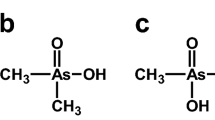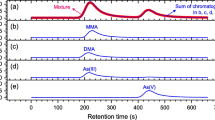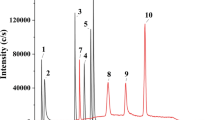Abstract
Inorganic arsenite (As3+) and arsenate (As5+) are well-known poisons, and the toxicity of As3+ is about ten times that of As5+. In this study, a simple, rapid, and sensitive method was developed for As3+ in plasma using electrospray ionization (ESI) tandem mass spectrometry (MS-MS). After washing plasma with trichloroethylene (TCE), As3+ in the aqueous layer was reacted with pyrrolidinedithiocarbamate (PDC, C4H8NCSS-), and the produced As(PDC)3 was extracted with methyl isobutyl ketone (MIBK); a 1-µl aliquot of the MIBK layer containing As(PDC)3 was introduced into the MS-MS instrument in the direct-flow injection mode. Other arsenic compounds such as As5+, monomethyl arsonic acid, dimethyl arsinic acid, arsenobetaine, arsenocholine, and tetramethyl arsonium did not produce As(PDC)3. Therefore, without liquid chromatographic separation, As3+ alone could be detected after washing with TCE followed by solvent extraction of As(PDC)3 with MIBK. Thus, inorganic As5+ was reduced to As3+ with thiosulfate, and then the total inorganic As was quantifi ed as As3+; As5+could be calculated by subtracting As3+from the total inorganic As. The MS-MS quantification was performed by selected reaction monitoring using a peak at m/z 114 of a product ion (C4H8NCS)+ formed by collision-induced dissociation from the precursor ion As(PDC)2 + at m/z 367. The mass spectral identification on MS-MS spectrum was possible even at 1 ng As3+/ml plasma. The calibration curve for As3+ showed linearity from 0.5 to 100 ng/ml plasma. The limits of detection by selected reaction monitoring were 0.3 ng/ml in water and 0.2 ng/ml in plasma. The analysis could be completed in less than 15 min, because chromatographic separation was not necessary before the MS-MS detection.
Similar content being viewed by others
References
Suzuki S, Suzuki Y (2005) Arsenic compounds and other inorganic poisons. In: Suzuki O, Watanabe K (eds) Drugs and poisons in humans: a handbook of practical analysis. Springer, Berlin Heidelberg New York, pp 637–647
Lalwani S, Dogra TD, Bhardwaj DN, Sharma RK, Murty OP (2006) Study on arsenic level in public water supply of Delhi using hydride generator accessory coupled with atomic absorption spectrophotometer. Indian J Clin Biochem 21:70–76
Daughtrey EHJr, Fitchett AW, Mushak P (1975) Quantitative measurements of inorganic and methyl arsenicals by gas-liquid chromatography. Anal Chim Acta 79:199–206
Le XC, Lu X, Ma MS, Cullen WR, Aposhian HV, Zheng B (2000) Speciation of key arsenic metabolic intermediates in human urines. Anal Chem 72:5172–5177
Oliveila V, Samiento AM, Gómez-Ariza JL, Nieto JM, Sánchez-Rodas D (2006) New preservation method for inorganic arsenic speciation in acid mine drainage samples. Talanta 69:1182–1189
Inoue Y, Date Y, Sakai T, Shimizu N, Yoshida K, Chen H, Kuroda K, Endo G (1999) Identification and quantification by LC-MS and LC-ICP MS of arsenic species in urine of rats chronically exposed to dimethylarsinic acid (DMAA). Appl Organometal Chem 13:81–88
Sloth JJ, Larsen EH, Julshamn K (2004) Selective arsenic speciation analysis of human urine reference materials using gradient elution ion-exchange HPLC-ICP-MS. J Anal Atom Spectrom 19:973–978
Xie R, Johnson W, Spayd S, Hall GS, Buckley B (2006) Arsenic speciation analysis of human urine using ion exchange chromatography coupled to inductively coupled plasma mass spectrometry. Anal Chim Acta 578:186–194
Pettine M, Casentini B, Mastroianni D, Capri S (2007) Dissolved inorganic carbon effect in the determination of arsenic and chromium in mineral waters by inductively coupled plasma-mass spectrometry. Anal Chim Acta 599:191–198
Huang JH, Ilgen G, Decker B (2008) Sample pre-treatment to eliminate cationic methylated arsenic for determining arsenite on an anion-exchange column by high performance liquid chromatography-inductively coupled plasma mass spectrometry. Anal Chim Acta 611:48–55
Dufailly V, Noël L, Guérin T (2008) Optimization and critical evaluation of a collision cell technology ICP-MS system for the determination of arsenic in foodstuffs of animal origin. Anal Chim Acta 611:134–142
Minakata K, Suzuki M, Suzuki O (2009) Simple and selective determination of arsenite and arsenate by electrospray ionization mass spectrometry. Anal Chim Acta 631:87–90
Mulford CE (1966) Solvent extraction techniques for atomic absorption spectroscopy. Atom Absorp Newslett 5:88–90
Subramanian KS, Meranger JC (1981) Determination of arsenic (III), arsenic (V), antimony (III), antimony (V), selenium (IV) and selenium (VI) by extraction with ammonium pyrrolidinedithiocarbamate-methyl isobutyl ketone and electrothermal atomic absorption spectrometry. Anal Chim Acta 124:131–142
Mandal BK, Ogra Y, Suzuki KT (2001) Identification of dimethylarsinous and monomethylarsonous acids in human urine of the arsenic-affected areas in west Bengal, India. Chem Res Toxicol 14:371–378
Author information
Authors and Affiliations
Corresponding author
Rights and permissions
About this article
Cite this article
Minakata, K., Nozawa, H., Yamagishi, I. et al. Sensitive determination of arsenite and arsenate in plasma by electrospray ionization tandem mass spectrometry after chelate formation. Forensic Toxicol 27, 37–40 (2009). https://doi.org/10.1007/s11419-008-0064-8
Received:
Accepted:
Published:
Issue Date:
DOI: https://doi.org/10.1007/s11419-008-0064-8




